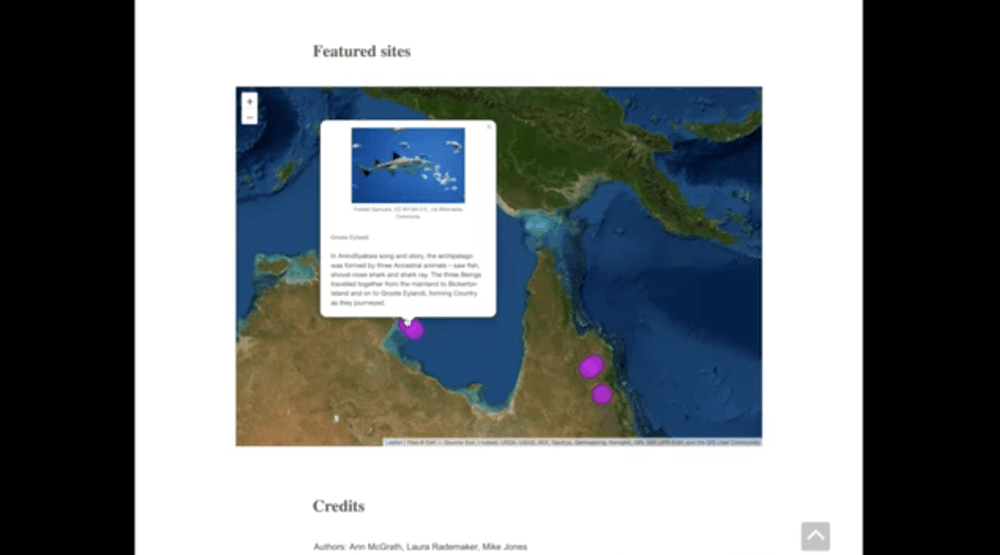As the Centre’s mapping project Marking Country moves into its final phase, the Centre’s Deputy Director Mike Jones shares an update.
When I first joined the Laureate program in 2019, our plan as a team was to create a digital atlas that used a national map to display lots of data and many layers of information. But though the shape of the continent continues to provide a frame of reference, it soon became clear we shouldn’t be trying to unify local stories from different communities or attempting to fill the map with as many sites as possible. Guided by our Indigenous Advisory Committee and our collaborating researchers, we realised that what we needed to do instead was create a space for deeper engagement with local landscapes, histories, and perspectives.
There will still be plenty of maps included in Marking Country. But the focus isn’t on location markers or individual sites, it’s about the way people engage with Country, and have done for many generations—since the Creation, as many communities see it—developing and maintaining a sense of place, creating rock art, shaping the landscape, moving from place to place, telling stories, singing songs, and learning family histories. Deep history is about these layers that in a broad sense mark Country, leaving a trace.
Whether the result is still an ‘atlas’ is an open question. Terms can be loaded with historical baggage, and we need to be careful about what we bring to this space. We need to ask the people we work with about the set of meanings that word has for them and if they are negative, we need to consider alternatives.
At this stage of the project there are a lot of moving parts, with a number of stories all at different stages. Although the project has been hampered by COVID lock-downs and border closures, we have several stories we are co-creating with Indigenous custodians around the country: Director Ann McGrath and I were privileged to visit Quinkan Country on the Cape York Peninsula in Queensland with local guide Johnny Murison; Ann and Amy Way had a recent trip to Koolmandanji Place (also known as Carnarvon Gorge) in Queensland led by Jackie Huggins and Uncle Fred (Cotto) Conway; Ben Silverstein and I are collaborating with Nyamba Buru Yawuru in and around Broome; Laura Rademaker (former Deputy Director, now collaborating scholar) is working with the Groote Eylandt community; Ann and cultural mapping expert Kim Mahood have worked with families in the Willandra Lakes district in south-western NSW; collaborating scholar Mary Anne Jebb is developing material with Woddordda and Ngarinyin people in the Kimberley; and Ann is working with Emma Batchelor on a more general story about historical maps.
Over the next month or two we will be confirming the stories that will be included for the Marking Country launch, drafting content, identifying the images and videos we will use, and getting a better sense of the themes that are emerging. It’s also vital that during this time we keep taking material back to community participants and collaborators for feedback. Once we have further developed the content, we will also spend time reviewing our work with the project’s Senior Advisor, Professor Jackie Huggins.
From this point on it is a very iterative process, and the iterations will get shorter right up until launch as we finalise content and test the site. Our developer Tabs Fakier is key to this process. The content we gather and the messages we want to convey inform her design process and the technologies used. As it’s not possible to custom build every story, these designs then become templates that help shape other stories. With the launch booked for November, and content from fieldwork still coming in, the timeframes are tight, but we are looking forward to sharing the results with communities, researchers, and the public.
The past three years have been a fantastic experience, and we have all learned a great deal about working with communities interested in sharing deep time stories and rich cultural knowledge, as well as the challenges of developing significant digital public history resources. When Marking Country goes live in November, we hope it will become a valuable resource for anyone who wants to engage with some of the many long and diverse histories found right across these lands.
To understand more about the technical and web development aspect of this project catch up on this blog from Tabs Fakier: https://resdeephistprd.wpenginepowered.com/live-streaming-building-the-re-atlas


